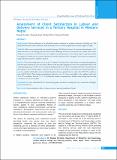Please use this identifier to cite or link to this item:
https://hdl.handle.net/20.500.14356/1154Full metadata record
| DC Field | Value | Language |
|---|---|---|
| dc.contributor.author | Shrestha, Deepak | - |
| dc.contributor.author | Aryal, Shreyashi | - |
| dc.contributor.author | Khatri, Resham | - |
| dc.contributor.author | Shrestha, Poonam | - |
| dc.date.accessioned | 2023-04-28T07:12:05Z | - |
| dc.date.available | 2023-04-28T07:12:05Z | - |
| dc.date.issued | 2021 | - |
| dc.identifier.citation | ShresthaD., Aryal S., Khatri R., & ShresthaP. (2021). Assessment of Client Satisfaction in Labour and Delivery Services in a Tertiary Hospital in Western Nepal. Journal of Nepal Health Research Council, 19(03), 555-562. https://doi.org/10.33314/jnhrc.v19i3.3613 | en_US |
| dc.identifier.issn | Print ISSN: 1727-5482; Online ISSN: 1999-6217 | - |
| dc.identifier.uri | http://103.69.126.140:8080/handle/20.500.14356/1154 | - |
| dc.description | Original Article | en_US |
| dc.description.abstract | Abstract Background: Patient satisfaction is an individual’s positive evaluation of a distinct dimension of health care. This study aimed to assess client satisfaction with maternity care in a tertiary hospital in the western region of Nepal. Methods: This cross-sectional study was conducted among 405 delivered women. A structured questionnaire of 21 items was used as a tool during exit interviews at their discharge. Each item was assessed on 5 points Likert scale. Student’s t-test and one-way ANOVA tests were applied to analyse parametric data. Binary logistic regression analysis was applied to identify the association of predictors with the satisfaction level. Strength of association was interpreted using odds ratio and 95% confidence interval. Results: The mean waiting time was 16.94 +5.57 minutes. Education level of the clients was statistically significant with the mean satisfaction score (p<0.001). Women with unwanted pregnancies were more satisfied than those with wanted pregnancies (p<0.001). Lower complete satisfaction rates were observed for pain control (6.4%), information at discharge (14.6%) and the degree of privacy in the ward (13.6%). Mothers who underwent instrumental delivery were less satisfied with health worker’s attitudes than those having vaginal deliveries (odds ratio 0.20, 95% confidence interval:0.05-0.84). Those having uncomplicated deliveries were 3.5 times more likely to be satisfied (odds ratio 3.50, 95% confidence interval: 1.1-11.5) with health workers communication. Mothers with waiting time less than 15 minutes were more satisfied. Conclusions: Lower educational level, unwanted pregnancy and shorter waiting time were associated with higher maternal satisfaction. Keywords: Client satisfaction; delivery; labour services; maternal satisfaction; Nepal | en_US |
| dc.language.iso | en | en_US |
| dc.publisher | Nepal Health Research Council | en_US |
| dc.relation.ispartofseries | July-Sep, 2021;3613 | - |
| dc.subject | Client satisfaction | en_US |
| dc.subject | delivery | en_US |
| dc.subject | labour services | en_US |
| dc.subject | maternal satisfaction | en_US |
| dc.subject | Nepal | en_US |
| dc.title | Assessment of Client Satisfaction in Labour and Delivery Services in a Tertiary Hospital in Western Nepal | en_US |
| dc.type | Journal Article | en_US |
| local.journal.category | Original Article | - |
| Appears in Collections: | Vol. 19 No. 03 (2021): Vol 19 No 3 Issue 52 Jul-Sep 2021 | |
Files in This Item:
| File | Description | Size | Format | |
|---|---|---|---|---|
| 3613-Manuscript-25075-1-10-20211215.pdf | Fulltext Download | 255.51 kB | Adobe PDF |  View/Open |
Items in DSpace are protected by copyright, with all rights reserved, unless otherwise indicated.
